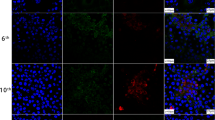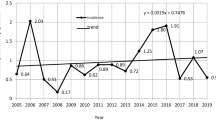Abstract
Measles continues to be a major public health issue causing substantial outbreaks worldwide, mostly affecting young children. Molecular analysis of measles viruses provides important information on outbreak linkages and transmission pathways that can be helpful towards implementation of appropriate control programs. In Pakistan, the control of measles is still tenuous, and progress towards elimination has been irregular and challenging. In the 2013 measles outbreak we received 4,682 sera collected from suspected patients in 23 districts across Sindh. A total of 3,283 samples were confirmed measles positive using IgM ELISA with the highest infection rate in children aged 1-12 months. Males were more affected than females and a visible peak was observed from January to April. Among the 3,283 cases, 59.1% were unvaccinated, 29.6% had received 1 dose and 10.3% had received 2 doses of measles vaccine while 0.85% had an unknown vaccination status. For genotype detection and phylogenetic analysis, 60 throat swab samples were collected from suspected patients below 15 years of age in eight districts of Sindh province. Forty four (73%; 44/60) throat swab samples were successfully genotyped using RT-PCR. Phylogenetic analyses based on partial sequences of the nucleocapsid protein gene revealed that all Pakistani measles virus strains belonged to genotype B3 and were closely related to those isolated from neighboring countries such as Iran, Afghanistan (99.1–100%) and India with 98.6 – 99.6% nucleotide homology. This is the first report on the phylogenetic analysis of measles B3 genotype strains from Pakistan and highlights the need for strengthening the surveillance systems and improving immunization coverage across the country.





Similar content being viewed by others
References
Perry RT, Gacic-Dobo M, Dabbagh A, Mulders MN, Strebel PM et al (2014) Global control and regional elimination of measles, 2000–2012. MMWR Morb Mortal Wkly Rep 63:103–107
Orenstein WA, Perry RT, Halsey NA (2004) The clinical significance of measles: a review. J Infect Dis 189:S4–S16
Bellini WJ, Rota JS, Lowe LE, Katz RS, Dyken PR et al (2005) Subacute sclerosing panencephalitis: more cases of this fatal disease are prevented by measles immunization than was previously recognized. J Infect Dis 192:1686–1693
Kremer JR, Brown KE, Jin L, Santibanez S, Shulga SV et al (2008) High genetic diversity of measles virus, world health organization european region, 2005–2006. Emerg Infect Dis 14(1):107–114
World Health Organization (2003) Update of the nomenclature for describing the genetic characteristics of wild-type measles viruses: new genotypes and reference strains. Wkly Epidemiol Rec 78(27):229–232
WHO (2012) Measles virus nomenclature update. Wkly Epidemiol Rec 87:73–80
Rota PA, Liffick SL, Rota JS, Katz RS, Redd S et al (2002) Molecular epidemiology of measles viruses in the United States, 1997-2001. Emerg Infect Dis 8:902–908
Rota PA, Brown K, Mankertz A, Santibanez S, Shulga S et al (2011) Global distribution of measles genotypes and measles molecular epidemiology. J Infect Dis 204:S514–S523
World Health Organization VPI/DCD/EMRO (2011) Measles and rubella monthly bulletin, Week 52. http://www.emro.who.int/images/stories/vpi/documents/measles_rubella_2011.pdf. Accessed 15 Mar 2017
WHO (2007) Manual for the diagnosis of measles and rubella infection, 2nd edn. World Health Organization, Geneva
Bankamp B, Byrd-Leotis LA, Lopareva EN, Woo GK, Liu C et al (2013) Improving molecular tools for global surveillance of measles virus. J Clin Virol 58:176–182
Tamura K, Peterson D, Peterson N, Stecher G, Nei M et al (2011) MEGA5: molecular evolutionary genetics analysis using maximum likelihood, evolutionary distance, and maximum parsimony methods. Mol Biol Evol 28:2731–2739
Haddad-Boubaker S, Rezq M, Smeo M-N, Yahia AB, Abudher A et al (2010) Genetic characterization of clade B measles viruses isolated in Tunisia and Libya 2002–2009 and a proposed new subtype within the B3 genotype. Virus Res 153:258–264
Simons E, Ferrari M, Fricks J, Wannemuehler K, Anand A et al (2012) Assessment of the 2010 global measles mortality reduction goal: results from a model of surveillance data. Lancet 379:2173–2178
Organization WH (2014) Global control and regional elimination of measles, 2000–2012. Wkly Epidemiol Rec 89:45–52
Goodson JL, Masresha BG, Wannemuehler K, Uzicanin A, Cochi S (2011) Changing epidemiology of measles in Africa. J Infect Dis 204:S205–S214
Wairagkar N, Chowdhury D, Vaidya S, Sikchi S, Shaikh N et al (2011) Molecular epidemiology of measles in India, 2005–2010. J Infect Dis 204:S403–S413
Muscat M, Shefer A, Ben Mamou M, Spataru R, Jankovic D et al (2014) The state of measles and rubella in the WHO European Region, 2013. Clin Microbiol Infect 20:12–18
Riddell MA, Rota JS, Rota PA (2005) Review of the temporal and geographical distribution of measles virus genotypes in the prevaccine and postvaccine eras. Virol J 2:87
Rota PA, Brown K, Mankertz A, Santibanez S, Shulga S et al (2011) Global distribution of measles genotypes and measles molecular epidemiology. J Infect Dis 204:S514–S523
Rota J, Lowe L, Rota P, Bellini W, Redd S, Dayan G et al (2006) Identical genotype B3 sequences from measles patients in 4 countries, 2005. Emerg Infect Dis 12(11):1779–1781
Mulders MNRP, Brown K, Goodsonb J (2015) Genetic diversity of wildtype measles viruses and the global measles nucleotide surveillance database (MeaNS). Wkly Epidemiol Rec 90:373–380
Gouandjika-Vasilache I, Waku-Kouomou D, Ménard D, Beyrand C, Guye F et al (2006) Cocirculation of measles virus genotype B2 and B3. 1 in Central African Republic during the 2000 measles epidemic. J Med Virol 78:964–970
Hanses F, Truong AT, Ammerlaan W, Ikusika O, Adu F et al (1999) Molecular epidemiology of Nigerian and Ghanaian measles virus isolates reveals a genotype circulating widely in western and central Africa. J Gen Virol 80:871–877
Kouomou DW, Nerrienet E, Mfoupouendoun J, Tene G, Whittle H et al (2002) Measles virus strains circulating in Central and West Africa: geographical distribution of two B3 genotypes. J Med Virol 68:433–440
Mulders MN, Nebie YK, Fack F, Kapitanyuk T, Sanou O et al (2003) Limited diversity of measles field isolates after a national immunization day in Burkina Faso: progress from endemic to epidemic transmission? J Infect Dis 187:S277–S282
Roy M, Son A, May RM (1982) Directly transmitted infectious diseases: control by vaccination. Science 215:26
Moss WJ, Strebel P (2011) Biological feasibility of measles eradication. J Infect Dis 204:S47–S53
Organization WH (2009) Measles vaccines: WHO position paper. Wkly Epidemiol Rec 84:349–360
Orenstein WA, Gay NJ (2004) The theory of measles elimination: implications for the design of elimination strategies. J Infect Dis 189:S27–S35
Riaz H (2013) Public health failings behind Pakistan’s measles surge. The Lancet 381:189
Khan T, Qazi J (2015) Measles hectic in Pakistan; upsurge versus the lurking vaccination. J Pak Med Assoc 5:213–214
Acknowledgements
This manuscript represents the findings of a study conducted by a Ph.D student without any kind of funding, grant or financial support.
Author information
Authors and Affiliations
Corresponding author
Ethics declarations
Conflict of interests
The authors declare that they have no competing interests.
Ethics approval and consent to participate
This study was approved by the Internal Review board of National Institute of Health, Islamabad, Pakistan
Consent to participants
A written informed consent was obtained from the patients’ parents or guardians before the collection of blood samples.
Electronic supplementary material
Below is the link to the electronic supplementary material.
705_2017_3524_MOESM1_ESM.docx
Table S1. Characteristics of 44 positive throat swabs collected from the 1st January to 15th Febuary 2013 from different districts of Sindh, Pakistan. (DOCX 25 kb)
Rights and permissions
About this article
Cite this article
Zaidi, S.S.Z., Hameed, A., Ali, N. et al. A measles outbreak in Sindh, Pakistan caused by a genotype B3 virus. Arch Virol 162, 3603–3610 (2017). https://doi.org/10.1007/s00705-017-3524-9
Received:
Accepted:
Published:
Issue Date:
DOI: https://doi.org/10.1007/s00705-017-3524-9




